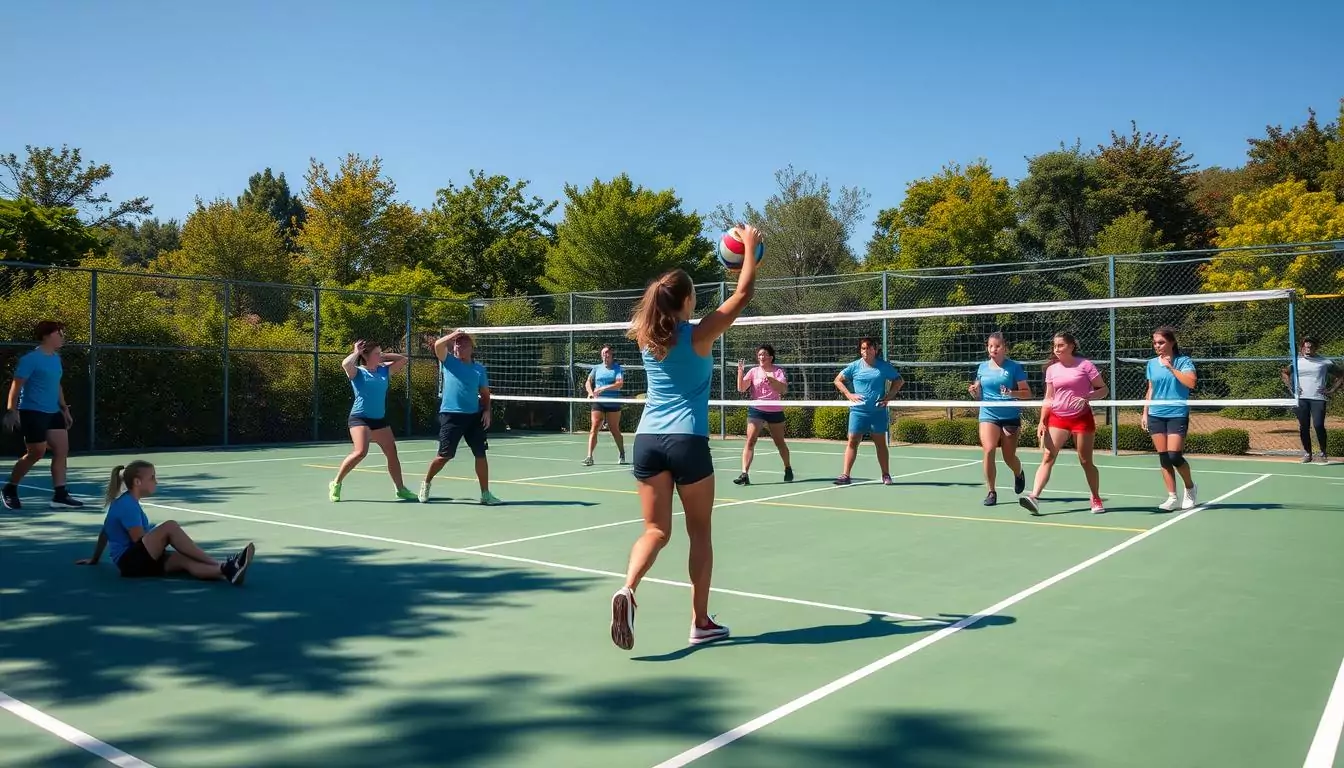As a passionate volleyball player, I’ve found that a good warm-up is key. Warming up before games or training boosts blood flow and gets muscles ready. It also lowers injury risks. A good warm-up can really improve your game.
In this article, we’ll explore the science behind warm-ups and what makes them important. We’ll look at the key parts of a good warm-up and how to make yours better. Whether you play for fun or aim to be a pro, a solid warm-up can elevate your game.
Key Takeaways
- Warm-up routines are vital for volleyball players, boosting performance and cutting injury risks.
- A good warm-up has three main parts: general warm-up, sport-specific warm-up, and mental prep.
- Exercises like Ball Throw Drill, Defense Drill, Hitting Drill, and Passing Drill are key for getting ready.
- Proper warm-up techniques help players improve their skills, like passing, hitting, setting, and serving.
- Warm-ups are essential for all players, from casual leagues to competitive games.
Importance of Warm-up Routines in Volleyball
As a volleyball player, I know how vital a good warm-up is. It gets my body and mind ready for the game or practice. This is key for better performance, avoiding injuries, and staying focused.
Benefits for Performance
Warm-ups boost my volleyball skills in many ways. They make my muscles warm and flexible, which helps me move faster and stronger. Studies show that dynamic warm-ups, which mimic volleyball moves, are better than static stretches.
Preventing Injuries
Good warm-ups help prevent injuries. They get my muscles and joints ready for the game’s intensity. This way, I’m less likely to get hurt. Research says static stretches might not help much and could even be harmful.
Mental Preparation
Warm-ups also prepare my mind for the game. They include visualizations and team talks. This mental prep helps me stay focused and perform well.
In short, a thorough warm-up routine is essential for any volleyball player. It improves performance, prevents injuries, and keeps the mind sharp. By understanding the value of warm-ups, I can prepare better and succeed on the court.
Basic Principles of a Good Warm-up

Getting your body ready for volleyball is key to perform well and stay injury-free. A good warm-up should have three main parts: start slow, use your whole body, and include dynamic movements.
Gradual Increase in Intensity
Begin with light cardio like walking or jogging for 5-10 minutes. This raises your heart rate and blood flow. It warms up your muscles for more intense activities.
Full-Body Engagement
Your warm-up should work all major muscle groups, like legs, core, shoulders, and arms. This makes sure your whole body is ready for the game or practice.
Incorporating Dynamic Movements
Use dynamic stretches like leg swings and arm circles instead of static stretches. These movements prepare your muscles and joints for volleyball’s demands.
By sticking to these principles, you can make a warm-up that gets you ready for the game. It also helps prevent injuries and boosts your volleyball skills.
Timing Your Warm-up
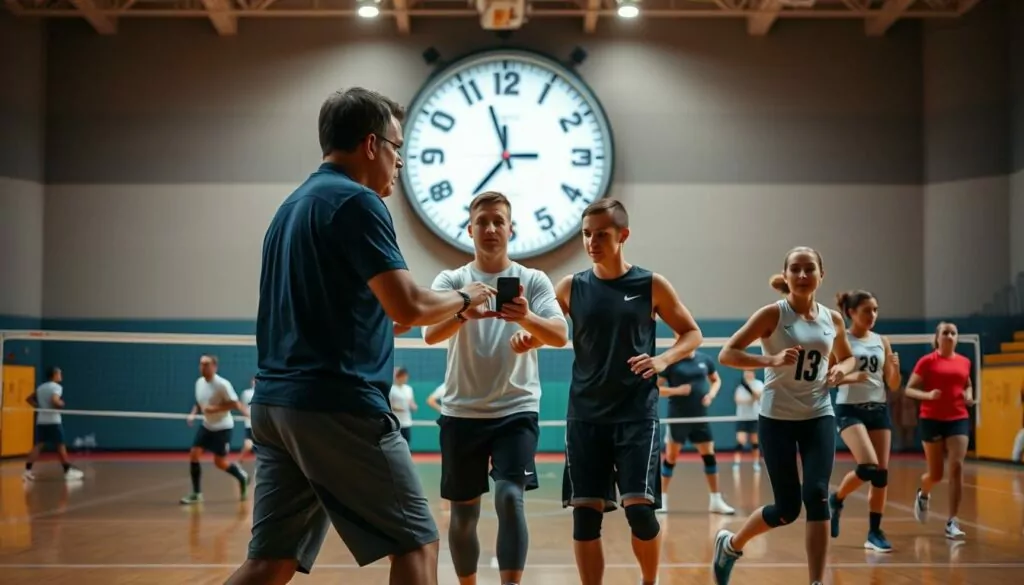
Getting your body ready for volleyball is key, and when you warm up matters a lot. A good warm-up lasts 5 to 10 minutes and includes 5 to 10 exercises. This mix gets your muscles ready and your body set for the game or practice.
Warm-up Duration Recommendations
The article suggests doing 20 dynamic warm-up exercises. It focuses on balance (25%), core (20%), and stretching to prepare for volleyball. This warm-up gets athletes ready in a short time.
Pre-Match vs. Daily Practices
Warm-ups can differ for games and daily practices. Before a game, you might do more, like hitting drills. Daily practices can be shorter but should prepare you well.
Finding the right balance is important. You want to prepare enough without getting too tired. Timing your warm-up right helps your body get ready for a great game.
Stretching Techniques for Volleyball
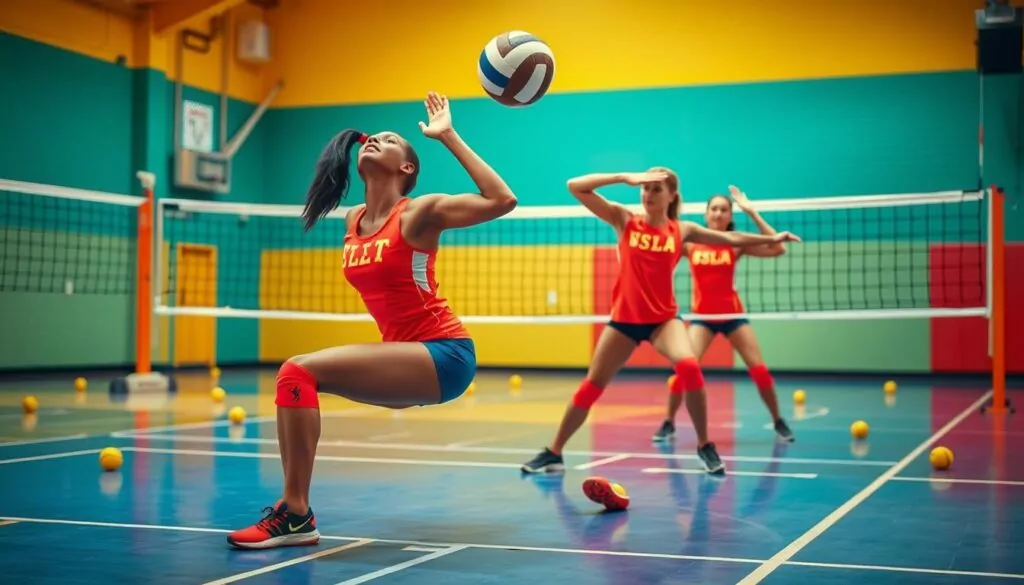
Stretching is key for volleyball players to stay flexible, avoid injuries, and play better. Choosing between static and dynamic stretches is important for warm-ups.
Static vs. Dynamic Stretching
Static stretches are good for cooling down after a game. But, dynamic stretches are best for warming up before a game. They get your heart rate up and muscles ready for action.
Key Stretches for Volleyball Players
- Leg Swings: These stretches work on the hips, hamstrings, and quads, vital for volleyball.
- Arm Circles: Moving your arms in circles warms up your shoulders and upper body.
- Lunges: Step-back lunges with a twist get your core, hips, and legs ready for volleyball’s fast moves.
- Hip Openers: The spider-man exercise is great for warming up your hips, core, and shoulders.
It’s also important to do static stretches for your quadriceps, hamstrings, and calves. This keeps you flexible and lowers injury risk.
“Stretching is an essential component of any volleyball warm-up routine, as it helps prepare the body for the demands of the game while reducing the risk of injury.”
Warm-up Activities to Get You Moving
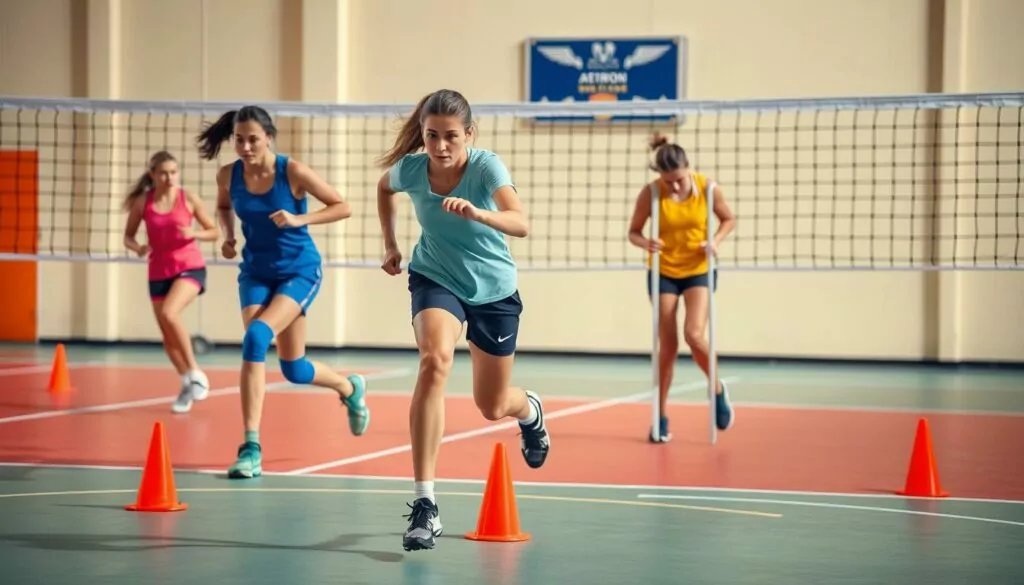
Getting your body ready for volleyball is key, and the warm-up is a big part of that. By doing different movements and drills, you can get your muscles ready. This helps with coordination and prepares you for a great session or game.
Jogging and Lateral Movements
Begin with light jogging to get your heart rate up and blood flowing. Add in shuffles, karaoke steps, and side lunges to work your legs. These moves boost your agility.
Jumping Exercises
Volleyball needs explosive power, so include jumps in your warm-up. Try jumping jacks, squat jumps, and box jumps. They get your legs ready for quick moves on the court.
Ball Toss Drills
Ball handling drills in your warm-up improve hand-eye coordination. Do simple tosses, catches, and ball taps. It gets your hands and eyes working together.
With a mix of warm-up activities for agility, plyometrics, and ball handling, you’ll be ready to play. A good warm-up routine is vital for your best volleyball performance and safety.
Working on Volleyball Skills During Warm-up
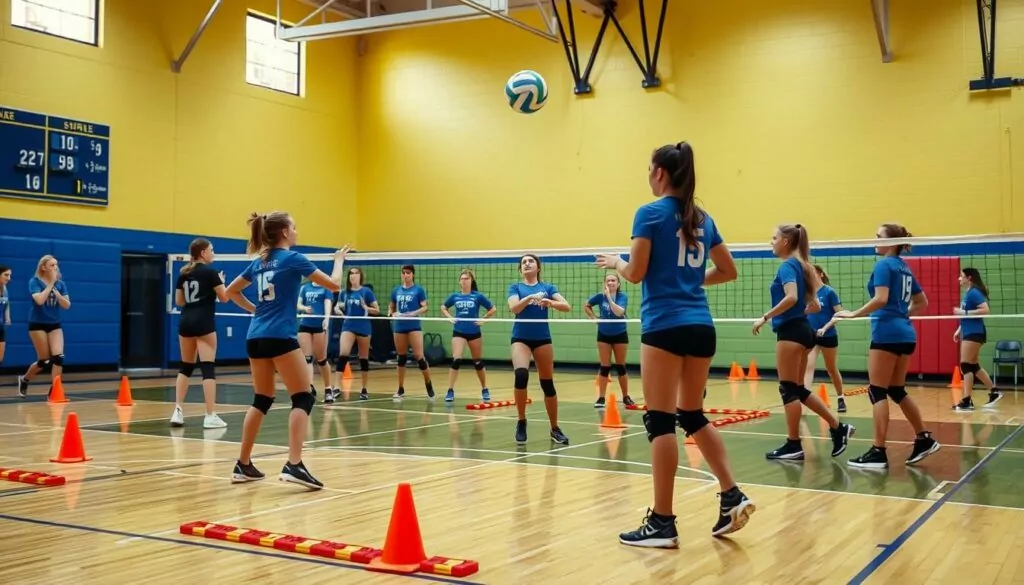
As a volleyball fan, I’ve learned that warming up with skill drills is key. Focusing on passing, serving, and setting can improve your game before it starts. It’s a great way to get ready and fine-tune your moves.
Passing Drills
Passing is vital in volleyball. So, warming up with partner passes or wall drills is a must. These exercises help you feel the ball and work on your footwork. Start with underhand passes and then move to overhead ones.
Serving Basics
Warming up your serving arm is important. Practice your basic serves, like float or jump serves. This will loosen your shoulder and boost your confidence.
Setting Practice
Setting is also a key skill. Warm up by setting against a wall or with a partner. This improves your hand positioning and control.
Adding these drills to your warm-up routine can give you an edge. You’ll get more practice and fine-tune your skills. This will help you perform better on the court.
“Warming up with skill-focused drills is a game-changer. It gets your body and mind ready to perform at the highest level.” – Sarah, NCAA Division I volleyball player
Team Bonding in Warm-ups
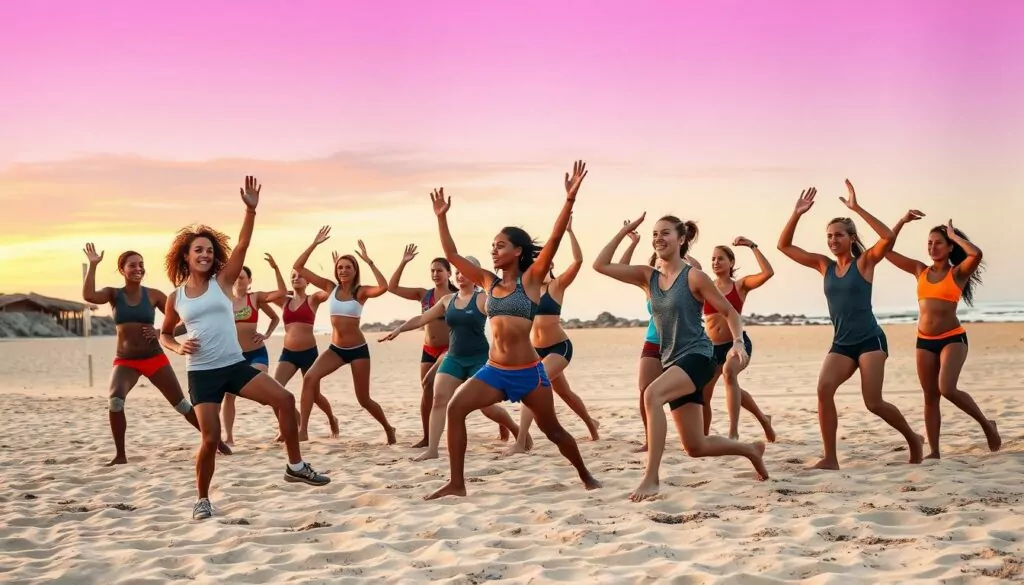
Volleyball is a team sport, and the warm-up is key to building team spirit. As a coach, I push my players to bond and unite during this time. Group exercises help them work better together, both on and off the court.
Group Activities
Group activities are great for team bonding during warm-ups. Simple tasks like circle passing or team serving lines make players talk and work together. These activities help players connect and feel more at ease as a team.
Encouragement and Support
Warm-ups are also a chance for players to support each other. I tell my team to cheer each other on and celebrate small wins. This positive vibe boosts morale and creates a supportive atmosphere for the game.
By adding team-building activities to warm-ups, coaches can strengthen team unity and communication. These exercises prepare players physically and set a supportive team tone for the match.
“When players feel connected and supported by their teammates, they are more likely to perform at their best and work together towards a common goal.”
Modifying Warm-up Routines for Skill Levels
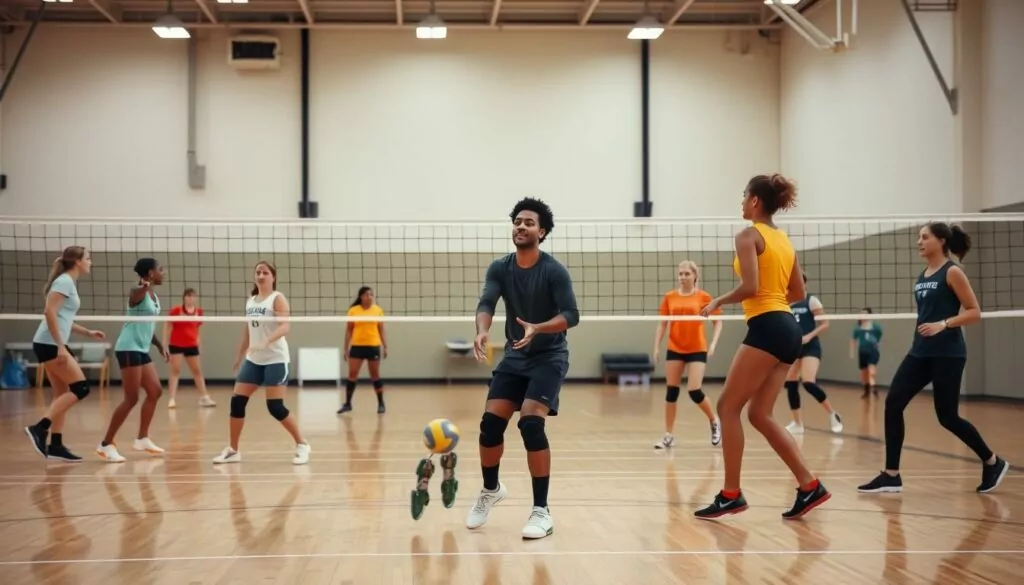
As a volleyball coach, I’ve found that a one-size-fits-all warm-up doesn’t work. Skill-specific warm-ups tailored to each player’s needs are key. They help maximize performance and ensure a great season.
Beginners
Beginners need a solid foundation. We start with basic movements and ball control exercises. These help them develop essential volleyball skills.
Drills like passing, setting, and simple serving routines are perfect. They make them comfortable on the court and ready for more intense training.
Intermediate Players
Intermediate players get more complex skill-specific warm-ups and higher intensity. We add advanced passing patterns, jump-serve drills, and position-specific movements. The goal is to challenge them while ensuring they’re warmed up and ready to perform.
Advanced Competitors
Advanced players get tailored routines to fine-tune their skills. We focus on position-specific agility drills, specialized hitting and setting sequences, and mental rehearsals. This prepares them for high-level competition.
Adjusting warm-ups to match player skill levels is a game-changer. It ensures everyone is prepared without overwhelming beginners. This approach boosts performance and reduces injury risk across all skill levels.
| Beginner Warm-up | Intermediate Warm-up | Advanced Warm-up |
|---|---|---|
|
|
|
Incorporating Strength Exercises
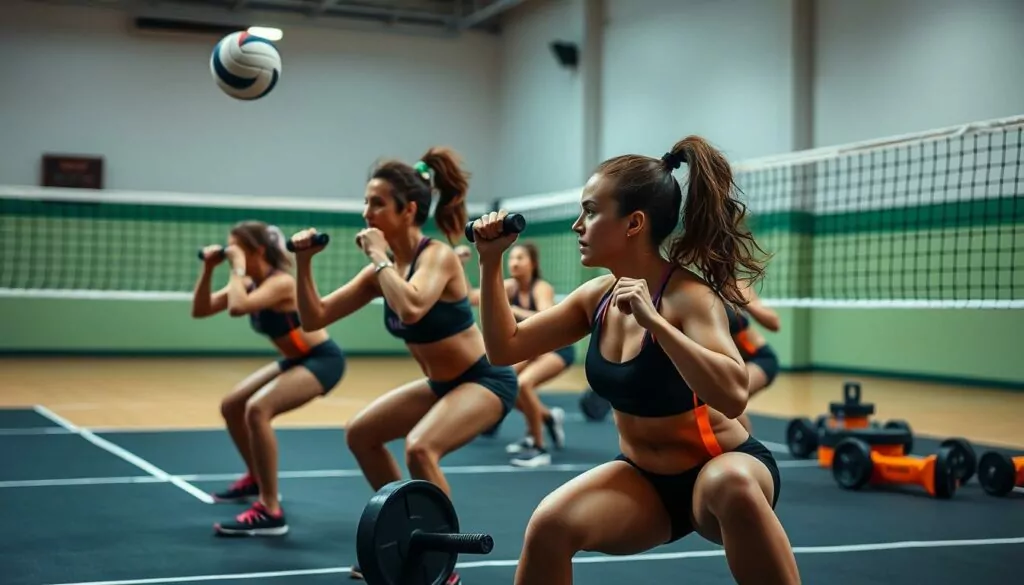
Volleyball is a demanding sport that needs agility, power, and endurance. To do well, adding strength exercises to your warm-up is key. Bodyweight exercises and core strengthening help prepare your body for the game. They also boost your strength and conditioning.
Bodyweight Exercises
Simple bodyweight exercises are great for your warm-up. Try push-ups, squats, and lunges to work out many muscles and raise your heart rate. These exercises build strength and help you keep good form during volleyball.
Core Strengthening
A strong core is vital for volleyball players. Do planks and Russian twists to boost stability and balance. These are key for powerful spikes, quick moves, and explosive jumps. Hip bridges also help, by working your glutes and hamstrings for better jumping.
| Exercise | Sets | Reps |
|---|---|---|
| Push-ups | 2-3 | 10-15 |
| Squats | 2-3 | 12-15 |
| Lunges | 2-3 | 8-10 per leg |
| Planks | 2 | 30-60 seconds |
| Russian Twists | 2-3 | 12-15 per side |
| Hip Bridges | 2-3 | 10-12 |
Adding strength training, core exercises, and bodyweight workouts to your warm-up will help your volleyball game. Start slow, focus on form, and increase intensity as you get stronger.
Using Music to Enhance Warm-up
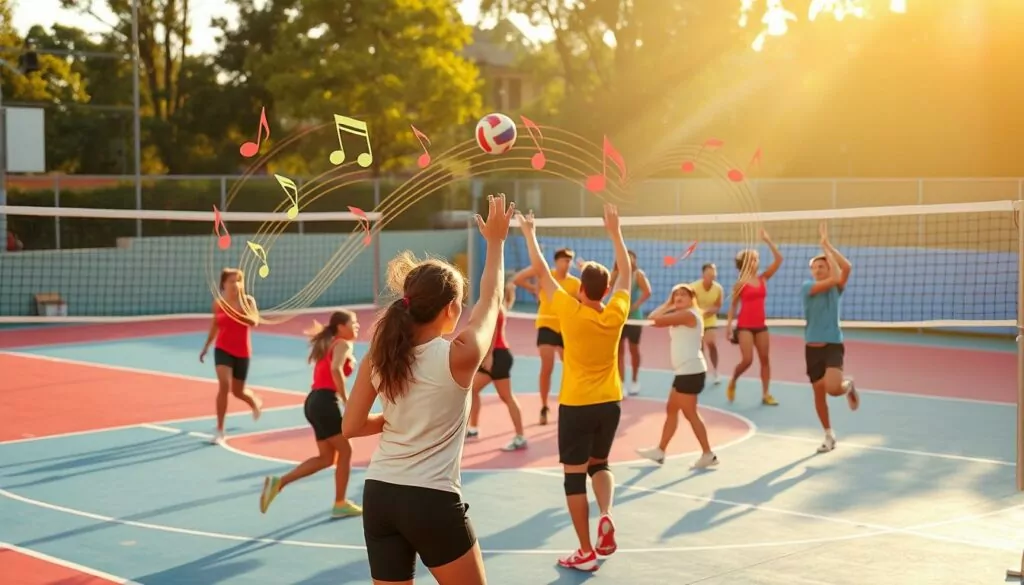
Volleyball players know a good warm-up is key. But did you know the right warm-up music can boost your game? It energizes players, creates a great pre-game atmosphere, and increases motivation techniques.
Creating the Right Playlist
Choosing the right music for your warm-up is important. Pick upbeat, motivating songs that match your warm-up’s rhythm. Make sure everyone on your team likes the music to create the best pre-game atmosphere.
How Music Affects Motivation
Research shows music’s big impact on sports performance. A study with 14 female college athletes found they were more motivated and powerful with their favorite music. They worked harder without feeling tired.
“Music has the power to energize players, create a positive pre-game atmosphere, and even boost motivation techniques during warm-ups.”
The right warm-up music can change the game. It helps players get ready and perform better. By picking the perfect playlist, your team can dominate on the court.
Evaluating Your Warm-up Routine
As a volleyball player, it’s key to check if your warm-up is working well. By watching how you and your teammates feel and play, you can spot what needs bettering. This helps you tweak your warm-up to keep it effective all season.
Seeking Feedback from Coaches
Getting advice from your coaches is super helpful. They know a lot and can help make your warm-up better. Listen to what they say and work together to make your routine the best it can be.
Keeping Track of Performance
Keeping a detailed log of your performance is important. Track things like jump height, agility, and serve accuracy. This lets you see how your warm-up is affecting you. It helps you make smart choices about your routine.
| Metric | Pre-Season | Mid-Season | Post-Season |
|---|---|---|---|
| Jump Height | 24 inches | 26 inches | 27 inches |
| Agility Time | 12 seconds | 11 seconds | 10 seconds |
| Serve Consistency | 80% | 85% | 90% |
Keep checking and improving your warm-up with coaching feedback. This makes sure you’re ready to play your best. It helps you and your team do better on the court.
“The warm-up is often the most overlooked, yet most important, part of a volleyball player’s routine. By taking the time to optimize your warm-up, you can unlock your true performance and set yourself up for success.”
Adapting Warm-ups for Different Conditions
As a volleyball player, I know how key it is to adjust my warm-up for the setting and weather. Whether indoors or outdoors, tweaking my warm-up can greatly impact my game and comfort.
Indoor vs. Outdoor Settings
For indoor games, my warm-up focuses on skill drills. The stable environment lets me hone my passing, setting, and serving skills. But, for outdoor games, I add exercises to prepare my joints for uneven surfaces and changing conditions.
Weather Considerations
Adjusting my warm-up for different weathers is vital. In cold weather, I extend my cardio warm-up to raise my body temperature and prepare my muscles. In hot and humid weather, I do more dynamic stretches and stay hydrated.
Regardless of the weather or setting, player safety is my top priority. By adapting my warm-up to the environmental adaptations of outdoor volleyball and using weather-specific warm-ups, I’m ready to perform at my best.
“Adapting my warm-up routine is essential for optimizing my performance, regardless of the playing conditions. I’m always willing to experiment and find the right balance to ensure I’m physically and mentally prepared for the match ahead.”
Sample Warm-up Routines for Different Matches
As a volleyball player, I’ve found that a good warm-up is key. It depends on the match’s demands. A quick warm-up can boost my performance, whether it’s a short match or a long tournament day.
Routine for a Short Match
For short matches, I do a fast, intense warm-up in 10-15 minutes. I start with dynamic stretches to get my muscles ready. Then, I practice skills like passing, setting, and serving.
Before the game, we have a quick team huddle. It helps us get mentally ready and focused on our strategy.
Routine for a Long Tournament Day
On a long tournament day, my warm-up is more detailed. I begin with light cardio to get my blood flowing. Then, I do dynamic stretches and mobility exercises.
Next, I focus on specific skills like serving and hitting. Between matches, I keep moving with short warm-ups. These include jogging, stretching, and quick ball touches to stay sharp.
The goal is to adjust the intensity and length of my warm-ups. This depends on the time I have and the match’s importance.
